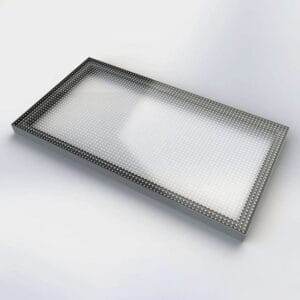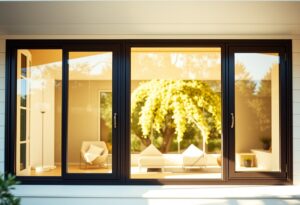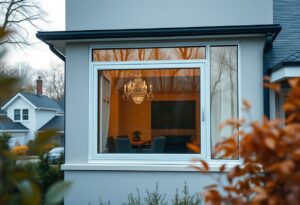It is important to ventilate your home. In the UK, we have made our homes more airtight over the years – blocking off chimneys, filling in air bricks, and installing insulation. While this is a great way to help keep the thermostat turned down in the winter months and lower our spending on heating, airtight buildings are not necessarily healthy places to be.
When it comes to keeping your home comfortable, ventilation is key. But what exactly is ventilation, and how does it work? Here’s everything you need to know about this important element of HVAC.
What is ventilation?
In short, ventilation is the process of moving air in and out of a space. This can be done naturally, through open windows and doors, or artificially, through a mechanical system.
Why is ventilation important?
There are two main reasons why ventilation is so important: air quality and temperature control. By moving air around, ventilation helps to remove pollutants and excessive moisture from the air. This not only improve air quality, but can also help to prevent mold and mildew growth. In terms of temperature control, ventilation helps to regulate the temperature of a space by drawing in cooler air from outside or expelling warm air.
How does ventilation work?
There are two types of ventilation: exhaust and supply. Exhaust ventilation works by removing air from a space, while supply ventilation brings fresh air into a space. Both types of ventilation can be achieved naturally or artificially.
Natural ventilation is the process of moving air in and out of a space without the use of mechanical systems. This is usually done through open windows and doors.
Artificial ventilation is the process of moving air in and out of a space using a mechanical system. This can be done through a variety of methods, including fans, blowers, and vents.
How can I improve my home’s ventilation?
There are a few things you can do to improve the ventilation in your home, including:
-Opening windows and doors regularly to let fresh air in
-Adding vents to key areas, such as the kitchen and bathroom
-Installing a whole-house fan
-Using an air purifier
By following these tips, you can help to ensure that your home has proper ventilation and is comfortable all year long.
What are the consequences of poor ventilation?
-Stuffy air, full of pollutants
-Condensation, mould, and other moisture problems
-Too much heat or cold
-Unhealthy air
-Breathing difficulties
There are some easy things you can do to get better ventilation in your home and improve the quality of the air you breathe. Taking these steps can help reduce the level of air pollutants and make your home feel more fresh and comfortable.-
-When cooking and showering, use extraction fans and open your windows and doors regularly to ventilate your home.
-Also, try to dry your laundry outdoors whenever possible.
Ventilation Methods
Rapid Ventilation – Rapid ventilation is the process of removing stale air and replacing it with fresh air from outside. This can be done by opening doors or windows.
Extraction fans are used to remove moisture from the air, preventing condensation and mold growth. They should be used during and after cooking, showering, and washing to keep your home free of moisture.
Background Ventilation – In order to maintain a healthy and comfortable home, it is important to have a background ventilation system in place. This will help to prevent the buildup of excess moisture and air pollutants. Background ventilation uses vents that are specifically designed to offer controllable ventilation through a building. Some of the ways this can be achieved include:
Different types of ventilation
If you have fitted new windows with trickle vents, make sure they are kept open.
Trickle vents should also be kept clear of paint, furniture or other items, which could block them.
Ventilate your home – Mechanical extractor fans
If you have a bathroom or kitchen extractor fan, make sure it is turned on when you make use of those rooms.
The latest models are controlled by sensors that switch the fan on automatically when they detect moisture, but if you have an older model you will still need to turn it on yourself.
Regularly clean the grilles and filters of your extractor fan to make sure it’s working effectively.
Ventilate your home – Whole-house ventilation system
If you don’t have a mechanical extractor fan or trickle vents in your home, you may want to consider having a whole-house ventilation system fitted.
Whole-house ventilation systems are normally controlled automatically and are designed to keep the air in your home fresh and free from moisture and other pollutants.
You can find out more about the benefits of whole-house ventilation systems from the Building Regulations Advisory Committees.
Ventilate your home – Draught-proofing
If you are worried about draughts, you may want to consider having your home draught-proofed.
You can normally do this yourself by fitting draught excluders at the bottom of doors and using silicone sealants or brush strips to block up gaps around windows.
You can also seal gaps around electrical sockets, light switches, skirting boards and door frames.
For more information on draught-proofing, take a look at the Energy Saving Trust’s Draught Busting Guide.
Ventilate your home – Open the windows
You should open the windows of your home regularly to let fresh air in and wet or humid air out.
Try to open the windows in all the rooms of your home for at least 10 minutes a day and give the bathroom or kitchen a good airing for longer periods.
If you have problems with condensation in your home, this may increase for a short time as you ventilate it.
However, if you regularly ventilate your home, the problem should gradually ease.
Ventilate your home – Drying clothes
Try to dry your clothes outdoors whenever possible to reduce the amount of damp air inside your home.
If you need to dry your clothes indoors, make sure you do this in a room that has a window that can be opened, or that has a mechanical extractor fan.
Ventilate your home – heating
Remember that the warmer the air in your home is, the more water vapour it can hold without condensation occurring.
You can help to reduce condensation in your home by heating it to a comfortable temperature.
Heating your home will also help to prevent mould growth.
You can find out more about how to heat your home in a cost-effective and energy-efficient way by visiting the Energy Saving Trust’s Heating and Insulation Advice Centre.
Ventilate your home – Storage
If you have storage space in your attic or loft, make sure it is dry and well ventilated by keeping windows or vents open and by making sure there is no water leaks or condensation.
In particular, make sure there is no condensation around your boiler or on the water tank in your loft.
If you have any storage space under your stairs or in cupboards and wardrobes, make sure the space is well ventilated by keeping doors open and keeping the shutters closed to keep draughts out.
You may also want to consider fitting an air vent in the space to improve ventilation.
Ventilate your home – Extractor fans
If you have a bathroom or kitchen extractor fan, make sure it is turned on when you make use of those rooms.
The latest models are controlled by sensors that switch the fan on automatically when they detect moisture, but if you have an older model you will still need to turn it on yourself.
Regularly clean the grilles and filters of your extractor fan to make sure it’s working effectively.
Ventilate your home – Whole-house ventilation system
If you don’t have a mechanical extractor fan or trickle vents in your home, you may want to consider having a whole-house ventilation system fitted.
Whole-house ventilation systems are normally controlled automatically and are designed to keep the air in your home fresh and free from moisture and other pollutants.
You can find out more about the benefits of whole-house ventilation systems from the Building Regulations Advisory Committees.
Ventilation Regulations
The new Ventilation Regulations that came into force on 15 June 2022 have put the issue of ventilation in the spotlight. The Department for Levelling Up, Housing and Communities (DLUHC) has issued statutory guidance explaining that a well-ventilated property must have methods in place to: extract water vapour and pollutants, supply a minimum level of outdoor air for occupants’ health (a minimum rate of 0.3 litres per second per m2 of internal floor area), quickly dilute indoor air pollutants and water vapour, and minimise the entry of external air pollutants. There are numerous ways to achieve the required level of ventilation, including installing windows with trickle vents, ensuring extraction systems are installed in kitchens and bathrooms, and implementing mechanical or whole-house ventilation systems.













